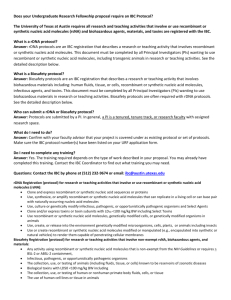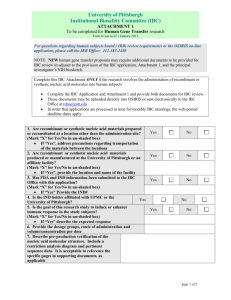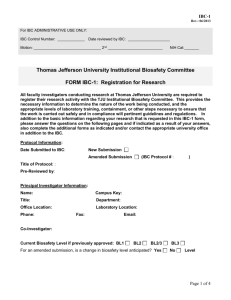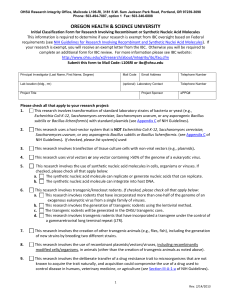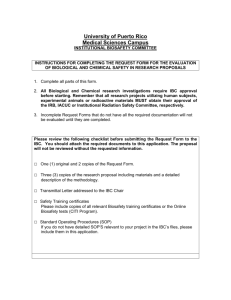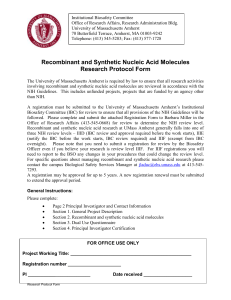IBC APPLICATION - California State University, Long Beach
advertisement
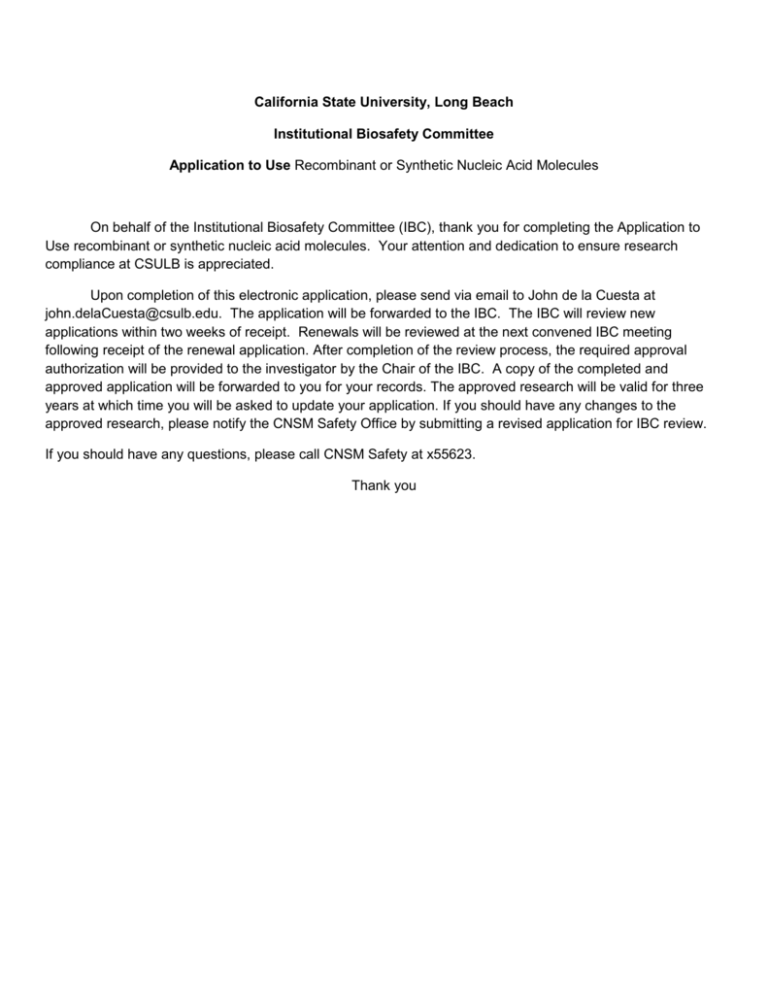
California State University, Long Beach Institutional Biosafety Committee Application to Use Recombinant or Synthetic Nucleic Acid Molecules On behalf of the Institutional Biosafety Committee (IBC), thank you for completing the Application to Use recombinant or synthetic nucleic acid molecules. Your attention and dedication to ensure research compliance at CSULB is appreciated. Upon completion of this electronic application, please send via email to John de la Cuesta at john.delaCuesta@csulb.edu. The application will be forwarded to the IBC. The IBC will review new applications within two weeks of receipt. Renewals will be reviewed at the next convened IBC meeting following receipt of the renewal application. After completion of the review process, the required approval authorization will be provided to the investigator by the Chair of the IBC. A copy of the completed and approved application will be forwarded to you for your records. The approved research will be valid for three years at which time you will be asked to update your application. If you should have any changes to the approved research, please notify the CNSM Safety Office by submitting a revised application for IBC review. If you should have any questions, please call CNSM Safety at x55623. Thank you APPLICATION TO USE RECOMBINANT OR SYNTHETIC NUCLEIC ACID MOLECULES California State University, Long Beach Institutional Biosafety Committee Name: Dept: Date: SECTION 1: RESEARCH DESCRIPTION Describe in two or three paragraphs the work to be conducted in your laboratory directly related to recombinant or synthetic nucleic acid molecules. Include general experimental procedures and any microbial, parasitic etc. agents involved. Funding Source (if applicable): SECTION 2: CHECK AND IDENTIFY AS APPLICABLE TO THE RESEARCH DESCRIBED ABOVE Use of recombinant or synthetic nucleic acid molecules Confined to microbial environment, in laboratory Intentional release to environment Transgenic Animals, identify Transgenic Plants, identify Other; specify Microbial/Infectious Agents Viruses, identify: Bacteria, identify: Cell Lines, identify: Fungi, identify: Prions, identify: Parasitic Agents, identify: Pre-exposure immunization required: Use of Animals Invertebrates, identify: Vertebrates, identify: AWB Protocol #: Use of infectious agents in animals Use of animals that are potential reservoirs of zoonotic diseases 1 11/07/2014jdlcnl SECTION 3: USE OF RECOMBINANT OR SYNTHETIC NUCLEIC ACID MOLECULES Provide the following information for the use of recombinant or synthetic nucleic acid molecules: a) Nature of inserted DNA sequence, including the species of origin, gene product and function (if known): b) Host(s) and vector(s) to be used: c) Will an attempt be made to express the foreign gene? Yes No SECTION 4: RISK ASSESSMENT AND RISK GROUP (RG) Check the Risk Group (RG) of the agent (bacteria, virus etc.) being used. Consult the ABSA website for Risk Group Classification http://www.absa.org/riskgroups/index.html RG1 RG2 RG3 Not identified No bacterial, viral, parasitic, etc. agent will be used SECTION 5: PHYSICAL CONTAINMENT AND BIOSAFETY LEVEL (BSL) Check the BSL of the agent (bacteria, virus etc.) being used. For Biosafety Level classification, go to http://www.cdc.gov/biosafety/publications/bmbl5/ Exempt BSL-1 BSL-2 BSL-3 Practices/BSL-2 Facility BSL-3 If you will construct transgenic animals, plants, fungi, or pathogens, what special measures will you take that ensure their containment? SECTION 6: LOCATIONS FOR USE AND STORAGE OF INFECTIOUS AGENTS AND RECOMBINANT OR SYNTHETIC NUCLEIC ACID MOLECULES List the location(s) where work will be conducted and where materials will be stored. Building Room Number Storage Unit ID Does this project involve CSULB-managed funds for the use of recombinant or synthetic nucleic acid molecules at a site other than CSULB? Yes No If yes, please list the site(s) here: 2 11/07/2014jdlcnl SECTION 7: TRAINING OF PERSONNEL All personnel working with recombinant or synthetic nucleic acid molecules shall undergo CNSM safety training and documented training by the Principle Investigator. If working at BSL 2, lab personnel shall undergo additional Biohazardous Materials training through the CNSM Safety Office. Describe how personnel will be trained in the handling of agents to be used: SECTION 8: ACCIDENTAL EXPOSURE You agree to contact CNSM Safety or Campus Environmental Health and Safety immediately in the event an employee, student, or coworker becomes ill and/or exhibits symptoms and signs consistent with an infection by an organism used in this research. Annual Renewals: Have there been any adverse events related to work with this organism over the past year? Yes No If yes, please describe: 3 11/07/2014jdlcnl INVESTIGATOR'S ASSURANCE California State University, Long Beach Institutional Biosafety Committee Project Title: 1. All persons conducting this work at CSULB have completed the CNSM Safety Program training, Biohazardous Materials training and Bloodborne Pathogen training as appropriate. Instruction shall be provided to all project personnel on the specific hazards associated with the work and the specific safety equipment, practices and behavior required during the course of the work and use of these facilities. 2. Any spill of biohazardous material, any equipment or facility failure (e.g., ventilation failure), and/or any breakdown in procedure that could result in potential exposure of laboratory personnel and/or the public to biohazardous material will be reported to CNSM Safety and Campus Environmental Health & Safety immediately. 3. Any proposed changes in my work that would result in an increased level of biohazard will be reported to the IBC before the change is implemented. 4. No work that requires IBC approval prior to initiation will be initiated or modified until approval is received from the IBC. 5. If this project involves recombinant or synthetic nucleic acid molecules, I have read and understand my responsibilities as Principal Investigator outlined in Section IV-B-7 of the NIH Guidelines, and will comply with these responsibilities. http://oba.od.nih.gov/oba/rac/Guidelines/NIH_Guidelines.htm 6. I have read the standard practices and physical containment procedures as defined for my BSL in of the NIH Guidelines. I agree to abide by these guidelines with respect to standard procedures and physical containment. 7. I have read and agree to dispose of all contaminated materials according to the CNSM Biohazardous Waste Policy and Needle Handling Policy. 8. I certify that the information provided within this application is accurate to the best of my knowledge. I also understand that, should I use the project described in this application as a basis for a funding proposal (either intramural or extramural), it is my responsibility to ensure that the description of the work in the funding proposal is identical in principle to that contained in this application. 9. I certify that all work on this project will be performed in accordance with all policies and procedures of the CNSM Safety Program and in accordance with NIH guidelines as appropriate for the risk group and BSL of the agents involved. 10. By electronically submitting this application to the IBC, I understand and agree that this serves as my electronic signature and affirm to the information provided therein. Lead Researcher Name: Signature: Electronic Signature 4 11/07/2014jdlcnl
